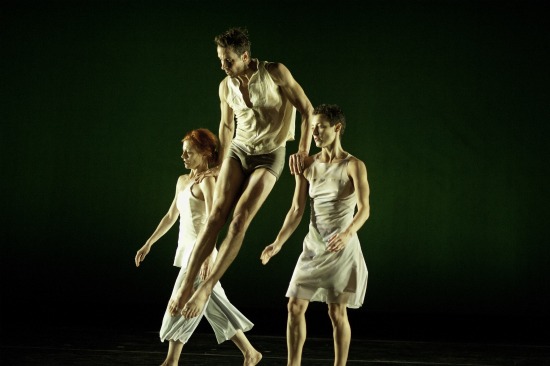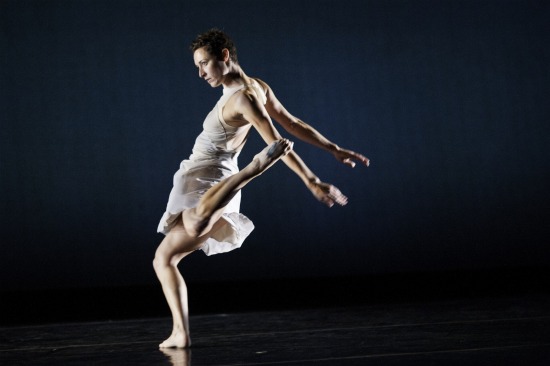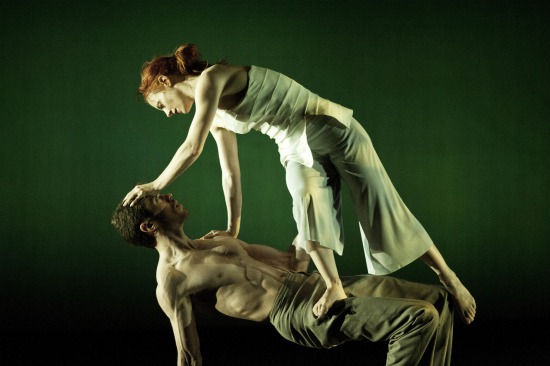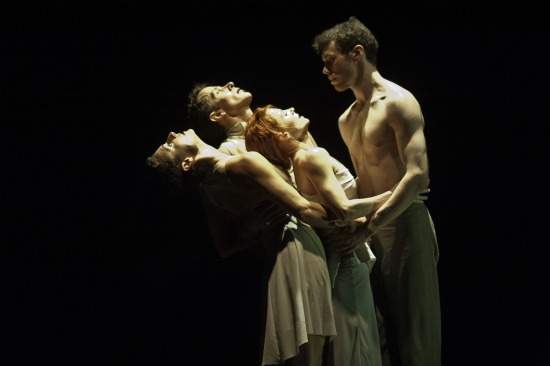
Leslie Kraus, Douglas Gillespie, and Bergen Wheeler in Kate Weare's Garden. Photo: Keira Heu-Jwyn Chang
The verdant place that gives Kate Weare’s disastrously beautiful Garden (2011) its name is no Eden. The weeds and brambles that sprout in human relationships flourish here, not quite crowding out the sudden, valiant blooms. Kurt Perschke’s set suggests that something is awry. The stage of the Joyce Theater—where Gotham Arts presented its FOCUS DANCE series of shared programs from January 3 through 8— contains no debris. But in one near corner sits the low stump of what must have been a forest giant—a tree far more ancient than the green-leaved one that hangs diagonally opposite it, upside down. Whether by hurricane or vandal woodcutter, damage has been done here.
The opening image is of Luke Murphy, supine, bent backward over the stump, while Douglas Gillespie, Leslie Kraus, and Bergen Wheeler stand beneath the inverted tree staring at him. The women’s pale outfits (by Sarah Cubbage) are curiously draped, hung, or bunched up. Taped music by Goldmund drops spare piano notes into a glade that lighting designer Brian Jones defines as sunny with shadows. In this tremulous world, Weare’s superb dancers create a fertile interplay of feelings and relationships—neither through recognizable “behavior” nor by the kind of acting that tells us “she loves him” or “he’s feeling jealous,” but with movement that seems drawn from primal urges, refined in choreographic fire, and cooled into expressive form.
These survivors unite in unison, pair up in various combinations, dance alone, and assist the weak ones or confront the strong. They make connections, then sever them. And always, they watch one another—on guard, trying to interpret, making decisions. Their actions are supported by an eclectic but elegantly chosen mix of music: three selections by pianist-composer Goldmund, a vintage Mexican pop song, two pieces by contemporary composer Keeril Makan, and two Renaissance works—one for lute by Marco dall’Aquila, one for lute and voice by Claudin de Sermisy.
The dancing in Gardencreates terrifyingly expressive, yet elusive images. Trying to interpret them is less important than soaking them up. When the two women, Kraus and Wheeler, walk in little tiptoe steps, I don’t see them as “playing lady” so much as practicing a delicate, inhibited form of progress for who knows what reason. When Wheeler begins a solo by spreading her legs wide apart and slowly descending into a very deep plié and then rocking from side to side, you can feel the move on a visceral level as a gearing up, a pausing for thought, a sensuous exercise, and more.
In many encounters, tenderness and cruelty mingle. Kraus and Murphy stand pressed together, then she pushes him away and, in the ensuing few seconds, places her hand on his head and presses him down and stands on him; then, atop the stump, she puts her hands on his head again and bends him over. Whenever the men and women form couples, they handle their partners with a kind of rough intrepidity; you can believe they’re trying to get under each other’s skin, to know what bone on bone feels like. When a man wheels a woman into the air, the act can seem exultant or dangerous. She could be attacking; he might consider hurling her away like a chair flung in rage.
They are so fine these dancers—Kraus and Gillespie, who’ve illuminated Weare’s work for years, and newcomers Murphy and Wheeler. What I love about them is the way they shade the earthy, gut-stirring movement. Whether they’re striding boldly, stamping their feet, sliding into embraces, or slowly arching back as if wondering what will fall from the sky, they let you feel ambiguities and counter-impulses. When does a push away contain the seeds of a pull toward? When does discomfort temper the nestling against a lover? What happens when you change your mind during a tempest?
One thing that appears to thread below the changing alliances and individual statements is that health lies in unity. Near the beginning, Gillespie, Kraus, and Wheeler pick Murphy up from the stump, carry him to a new place, and set him on his feet. In the last moments of Garden, all four cluster on the stump, and Murphy arches slowly, drastically backward. This is what we see as the lights fade. A man at the edge of an abyss, his friends holding him fast. For how long will they maintain this balance? How long will the garden grow?
Weare’s work shared the program with Kyle Abraham’s Live!: The Realest MC (2011), which I hadn’t seen before either. I planned to write about it, but discovered that around 20 minutes had had to been edited from it to fit the series’ 40-minutes-per-choreographer policy. It’s only fair to Abraham that I wait to comment until I’ve seen the whole work.



